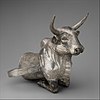Palaic language
| Palaic | |
|---|---|
| Region | Anatolia |
| Ethnicity | Palaic peoples |
| Extinct | around 1300 BCE |
Indo-European
| |
| Language codes | |
| ISO 639-3 | plq |
plq | |
| Glottolog | pala1331 |
Palaic is an extinct Indo-European language, attested in cuneiform tablets in Bronze Age Hattusa, the capital of the Hittites. Palaic, which was apparently spoken mainly in northern Anatolia, is generally considered to be one of four primary sub-divisions of the Anatolian languages, alongside Hittite (central Anatolia), Luwic (southern Anatolia) and Lydian (western Anatolia).
Its name in Hittite is palaumnili, or "of the people of Pala"; Pala was probably to the northwest of the Hittite core area, so in the northwest of present mainland Turkey. The region was overrun by the Kaskians in the 15th century BC, and the language likely went out of daily use at that time.
Sources[]
The entire corpus of Palaic spans only CTH 751-754 in Emmanuel Laroche's catalog of Hittite texts; in addition Hittite texts elsewhere cite passages in Palaic in reference to the weather god (Hittite Ziparwa), the leading God of the land of Pala.[1] In particular, CTH 750, a festival in Hittite for Ziparwa and associated deities, includes passages stating, "The Old Woman speaks the words of the bread in Palaic," or alternately "the words of the meal," though no Palaic passages are quoted. The Palaic-language texts are all from a religious context, with ritual and mythological content.[2] In addition to Zaparwa, the Palaumnili-speakers worshipped a sun deity (Luwian Tiwaz), the Hattian goddess Kataḫzip/wuri, and several others.
Morphology[]
In terms of its morphology, Palaic is a fairly typical specimen of Indo-European. Old Hittite has the genitive singular suffix -aš circa 1600 BC (compare Proto-Indo-European *-os); where Cuneiform Luwian instead uses the -ašša/i- adjectival suffix. Palaic, on the northern border of both, like later Hieroglyphic Luwian has both an -aš genitive and an -aša- adjectival suffix. Palaic also shows the same gender distinction as seen in Hittite, i.e. animate vs. inanimate; and has similar pronoun forms.
References[]
Further reading[]
- Melchert, H. Craig. "Notes on Palaic". In: Zeitschrift Für Vergleichende Sprachforschung 97, no. 1 (1984): 22-43. Accessed June 23, 2021. http://www.jstor.org/stable/40848728.
External links[]
- "Digital etymological-philological Dictionary of the Ancient Anatolian Corpus Languages (eDiAna)". Ludwig-Maximilians-Universität München. Archived from the original on 2017-02-25. Retrieved 2017-03-14.
- Catalog of Hittite Texts
- Genitive Case and Possessive Adjective in Anatolian by Craig Melchert
- Sasseville, David. ""To show" in Hittite and Palaic Ritual". In: Altorientalische Forschungen 46 (2019): 22−32. https://doi.org/10.1515/aofo-2019-0003
- Görke, Susanne & Sasseville, David. "Palaisch: Eine indogermanische Kleinkorpussprache in Zentralanatolien" In: Antike Welt 1/2021. pp. 6-7.
- Languages with Linglist code
- Anatolian languages
- Palaic peoples
- Languages attested from the 2nd millennium BC
- Languages extinct in the 14th century BC
